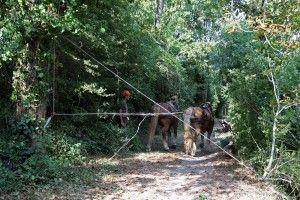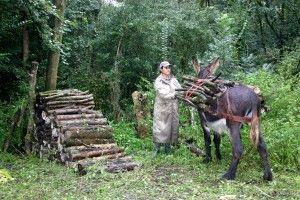Horse logging
What is this?
It is a technique of forestry management which consists in using horses to transport felled trees from the felling location to a collecting area using horses.
With greater respect for forest floors and less usage of fossil fuels, horse logging today is in tune with ecological concerns.
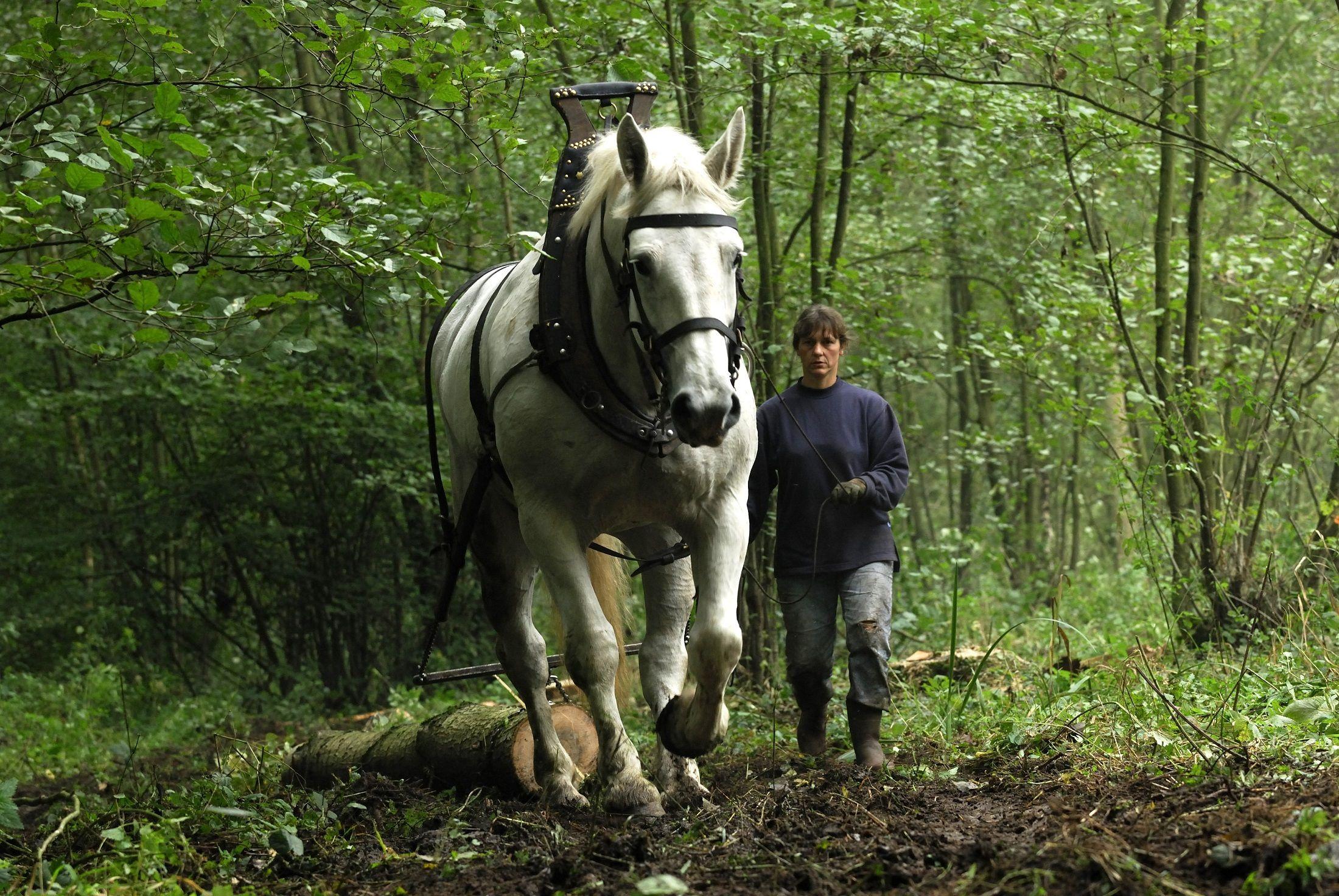
© JL Dugast – Boulonnais en traine directe
The avantages of horse logging
With the greater interest we are seeing today in protecting the environment, horse loggers bring a viable and ecological solution to the upkeep of forests
The Ecological Aspect
Extremely well adapted to fragile natural spaces, Natura 2000 (EU protected Areas) zones, coastal forests, peat bogs and wetlands, horses have a minimal impact on the areas where they work, their use requires little in the way of access infrastructure or tracks, their use does not result in soil compaction, and they have a much better grip on the soil than do tractors. The passage of horses respects the regeneration of the forest by not destroying saplings and leaving the soil behind them tidy.
- Due to their weak load-bearing capacity (approximately 0.5 bars), horses do not cause in soil compaction;
- Horses do not get bogged down, and can cross rivers and banks;
- Horses do not strip reserves. This stops the proliferation of mushrooms and rotting, does not result in a degradation in the quality of future trunks, and does not result in financial loss;
- By preserving saplings, horses contribute to the natural regeneration of forest flora;
- Horses do not require tracks. They can go through small paths or narrow pine forests;
- Horses can work in hard-to-reach hilly areas (steep slopes, boulders). The maximum gradient is of 45%. This, however, tires the horses more quickly and for better productivity, it is advised not to go over 10%;
- Horses can work in wetlands, without risking getting bogged down or getting into ruts;
- Horses do not produce any pollutants and do not create noise pollution. They dot present a risk of hydrocarbon or lubricant leakage, which would result in pollution of the soil and running water.
Source: Equi débardage
And horses are in fact a renewable energy!
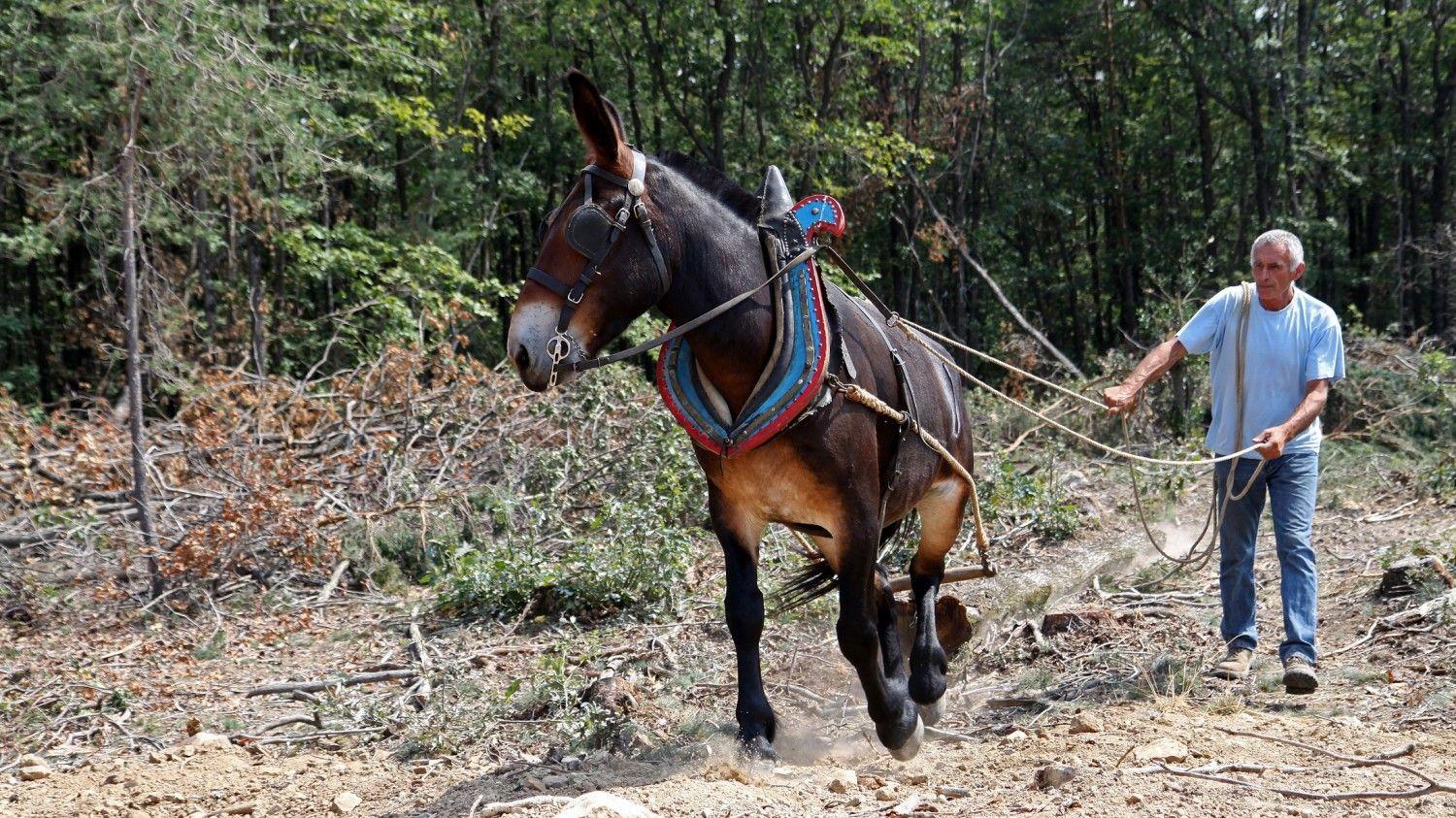
© E. Rousseaux – Mule Poitevine
Matters of Economy
Horses can work in areas that are impossible to reach for motorized vehicles (steep slopes, boulders, wet areas) and, in some cases, are less costly (small site, short distances…).
Horses represent minor investment and their ability to preserve natural resources limits a potential loss of income (no harm done to forests, no damage linked to putting access to the lot in place…).
Their manoeuvrability, reliability, intelligence and resistance to bad weather make them into an efficient work tool, whatever the terrain.
Average yield based on an average volume of wooden pieces dragged by a single horse.
| Average volume of wood pieces (m3) | 0,15 | 0,20 | 0,25 | 0,30 | 0,40 | 0,50 | >= 0,60 |
| Possible average yield (m3/hour) | 1,4 | 2,1 | 2,8 | 3,6 | 4,9 | 5,5 | As the average volume increases, the yield will stagnate or deteriorate (use of special materials) |
The average distance between forestry routes is 40m.
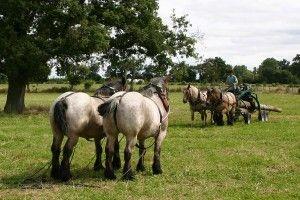
© E. Rousseaux – Ardennais avec un diable
The cost of forest animal traction
The work can be paid by the day, by the hour, or by the piece (cubic metre in general, stacked wood or tonne).
An overview of several sources from France, Luxembourg ad Germany, and of standard practices, leads to come up with an average price of €300 before tax per day. This would be for the work of a single logger working with one horse in harness dragging trunks.
For loggers who have a long daily commute or who require local accommodations for horse and logger, one can contemplate an additional €50 per day.
Rates can even go higher than €450 per day, depending on what materials are needed for the horse.
Source: Manuel d’utilisation de la traction animale en débardage forestier – ONF – Direction territorial Lorraine (Manual for the use of animal traction for forest logging – National Forests Office – Lorraine Territorial Management).
- © E. Rousseaux
- © E. Rousseaux
On the Social Side
Animal traction benefits from a strong capital of support among the greater pubic in general. These people normally realise that horses were used in the past to work forests, which reassures them and serves as a token of continuity for the forests.
Animal traction serves to broaden the range of technical solutions for exploitation that is respectful of the soil and what has settled on it. It is low in cost and enables the maintenance of specific jobs and know-how.
In addition, animal traction allows the maintenance of local and rural jobs: breeding, feeding of horses, farriering, harness-making, veterinary services…
The use of animal traction in forests makes it possible to preserve a genetic asset that is unique in the world by using draft horses.
Source: Manuel d’utilisation de la traction animale en débardage forestier – ONF – Direction territorial Lorraine (Manual for the use of animal traction for forest logging – National Forests Office – Lorraine Territorial Management).
Some Numbers
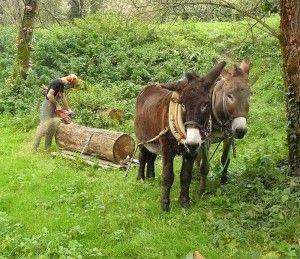
© Collection SFET
Depending on the constraints of the terrain: slopes, obstacles, density of undergrowth, rocks, density of growth, the average unit volume of the wood, felling direction, the distance the logs must be dragged out, yield can vary from 10 to 40 metres cubed, or 30-50 cubic metres per day per logger/horse
One pair of horses can pull n average volume of more than two metres cubed using modern equipment which is high-performance and adapted to the task (forwarder or timber arch, for example)
Although horses perform less well on large diameter trees (greater than 80cm), they are much more efficient for smaller diameters (40cm, average volume 1 cubic metre) thanks mainly to its good pulling power and its astonishing mobility in ore or less enclosed spaces.
Source: Débardage Cheval Environnement
Different Types of Work
A horse-logging operation is generally carried out in two phases:
1 – An extraction phase where the wood (trunks and/or cut residues) is transported from the felling location to a collection place not too far away.
2 – The actual logging in which the wood is actually transported from the collection place to a central location where it is stored before removal.
Selection of the type of transport used depends on how accessible the sites are and what sort of product needs t be transported.
There is a distinction between:
Direct Pull Extraction
Extraction using a swingle tree and skidding chain in which the horse drags the log behind him. This type of extraction can be done with one, two or three horses depending on the weight, often followed by a pick-up with a tractor at the path (or by barge, or rail or cable mast).
Extraction with a Forwarder:
The horse transports the wood using a forwarder which reduces the weight it has to pull.
Extraction of wood bundles for heating
Using a forecart called a bundler, the horse transports wood for heating already made up as faggots. These faggots are then usually picked up wither by a tractor or a horse-drawn vehicle.
Extraction with a Powered Forwarder
Horses can log several cubic metres of wood using a forwarder. This method requires 5 litres of petrol per 40 cubic metres of wood whereas a tractor uses one litre for one cubic metre.
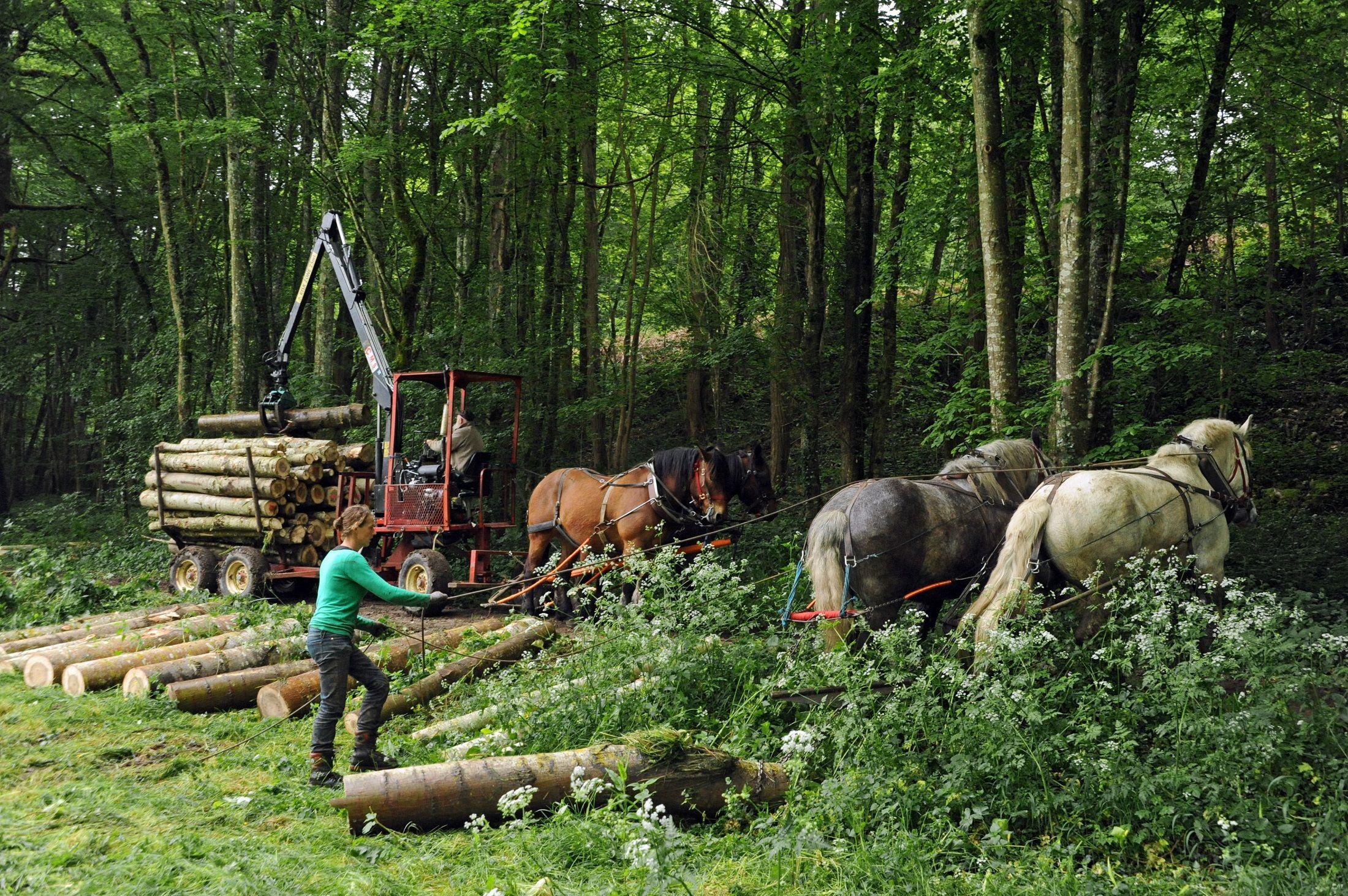
© JL. Dugast – Attroupement – Percherons / Porteur forestier hippomobile – Comtois
For More information about : Horse logging
- > http://www.debardage-cheval-environnement.com/
- > http://www.foret-debardage-a-cheval.fr/debardage.html
- > http://www.onf.fr/lorraine/++oid++17da/@@display_media.html
- > http://www.equi-debardage.com/
- > http://www.parc-vosges-nord.fr/html/telechargement/bulletins/dossier_bulletin_27.pdf
- > http://www.cecd.be/
- > http://filiere-equine-poitou-charentes.com/?page_id=4144
- > http://www.blavet.bzh/entretien-de-la-ripisylve
